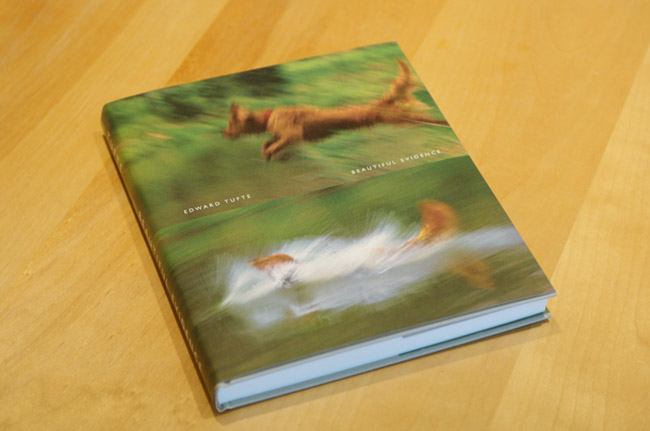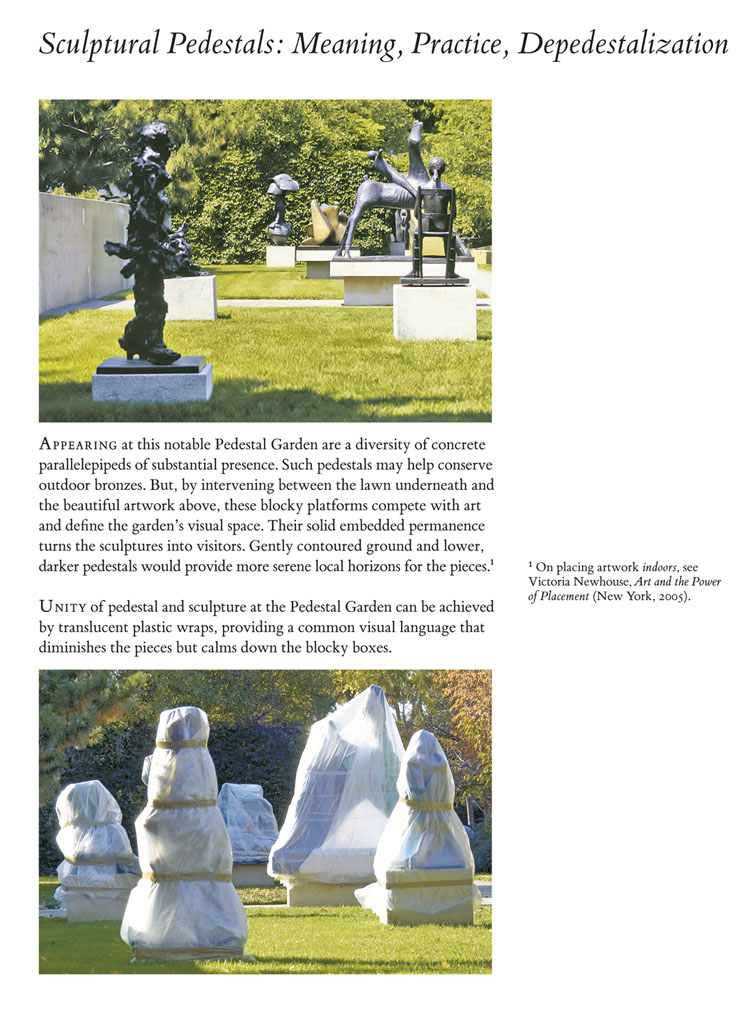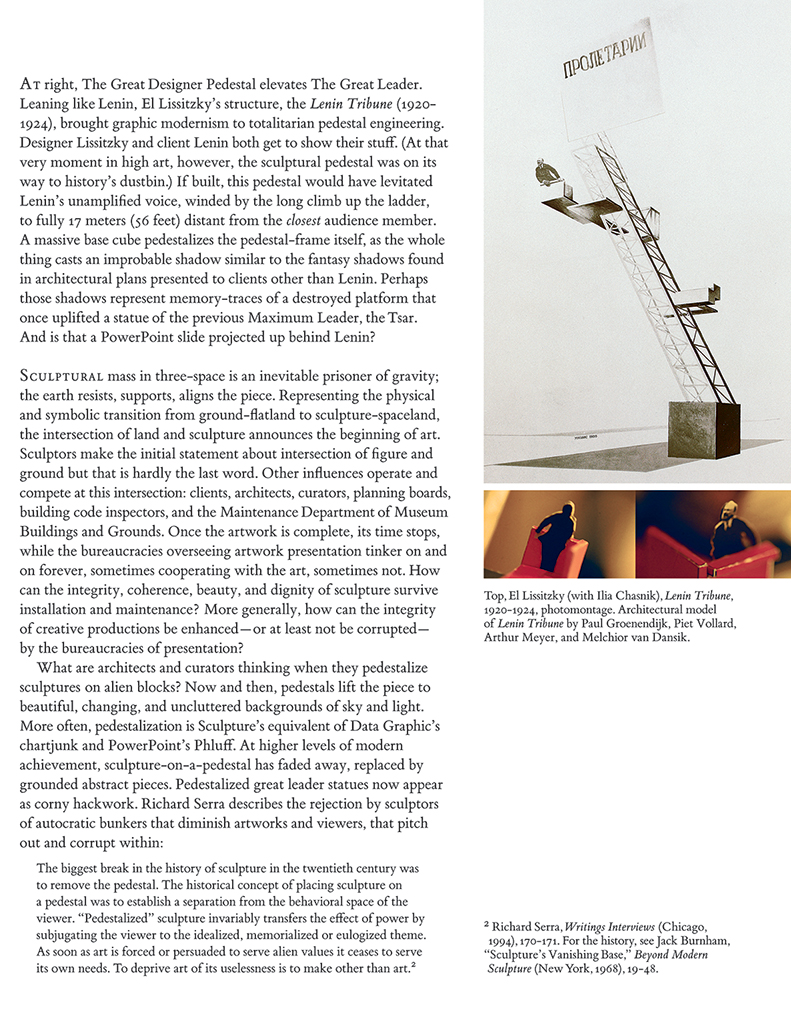|
All 5 books, Edward Tufte paperback $180
All 5 clothbound books, autographed by ET $280
Visual Display of Quantitative Information
Envisioning Information
Visual Explanations
Beautiful Evidence
Seeing With Fresh Eyes
catalog + shopping cart
|
Edward Tufte e-books Immediate download to any computer: Visual and Statistical Thinking $5
The Cognitive Style of Powerpoint $5
Seeing Around + Feynman Diagrams $5
Data Analysis for Politics and Policy $9
catalog + shopping cart
New ET Book
Seeing with Fresh Eyes:
catalog + shopping cart
Meaning, Space, Data, Truth |
Analyzing/Presenting Data/Information All 5 books + 4-hour ET online video course, keyed to the 5 books. |
A 2006-2013 chronicle of design, publishing, and consequences of my Beautiful Evidence.
[2006] I have completed Beautiful Evidence, except for the index and a few loose ends. We are currently proofing some difficult images on press, negotiating with printers, planning the order for paper and binding, and working through other production issues. Probably the major threats to breaking the schedule will be in color-correcting images and in importing some paper used in one section of the book.
I'm enormously grateful to all those who commented on drafts of 3 chapters of BE posted on this board over the years. The invisible college of Kindly Contributors suggested new examples, pointed out my mistakes, and caused me to rethink and rewrite parts of the posted material. It is not always easy to write parts of book in public; I am delighted with the results of our mutual experiment.
Thank you very much everyone!
-- Edward Tufte
We're moving at a steady but somewhat stately pace: color-corrections are underway; we may place an order for 50 tons of paper next week (an important deadline since the paper has to be made at the mill on a monthly schedule); I made a lot of minor changes to the manuscript during the 12 days on tour in Texas and New Mexico; most of the many copyright permissions have been obtained; some proofing press runs will be made this week.
-- Edward Tufte
The printer has now done several successful color proofing tests. This consists of actually printing, on press, a short run of several test sheets on our new paper Mohawk Options 100lb text (which we are using instead of our usual Monadnock Dulcet, because Options apparently has better ink holdout, which we have observed in the printing proofs, an important consideration for uncoated stock). Those tests included some extra color hits on difficult images, which worked for about half the images tested. We also did some proofing tests with key images on coated stock, but the unfortunate shiny reflections from the coated paper were decisive. We await a test printing of some of our color tints (e.g., hows does 2% yellow compare with 3% yellow?) and may see something on Monday. We're awaiting a digital file of a Verrocchio drawing from the Metropolitan Museum but otherwise all the nagging details have been cleaned up. Some color conversions (PMS colors replacing CMYK colors) have been made. A new page with a new example was added. And some difficult binding issues involving foldouts are now resolved after some test bindings at Acme Bookbinding.
I am still looking forward to books in May.
-- ET
All pre-press work is now complete. We'll start printing April 25, with some 29 press OKs (approval of the first sheets printed of each form) to do. There will be a minimum of 3 OKs per day, although I'm agitating for more each day (the printer is an hour-long drive from home so I'd like to do as much as possible for each day's trip).
On the first form printed, we'll set the color of the type (the density of the black used for the type, separate from the black used in images) that we'll be aiming at throughout the book. (The separate blacks for type and images allows independent adjustment of type and image while on press.) There remain some difficult color issues despite our pre-press tests and that is why we do all our own OKs. The press OKs will pretty much take all my time for the next 2 weeks. It is wonderful to see the freshly printed forms (a form has 8 pages up, or 16 book-pages total on the 2 sides of each sheet), since they are the physical manifestation of all the work for a long time now.
-- Edward Tufte
There are several good books on the process of bookmaking and book design. I've always appreciated Rauri McLean on book design and typography. About 3 years ago, Howard Gralla, a very good book designer, went over the BE spreads with me and reigned in my local pagewise optimization of typography and layout by enforcing a bit more consistency of typography and grids throughout the book. He also described one spread, which I then considered an imaginative solution to a difficult set of images, as the "worst designed spread he'd ever seen." Only 2 years later I somehow came to revise the spread, partly because I had some delightful new content to fit in, which allowed me to scrap the spread without having to admit that it was THAT bad!
With regard to descriptions of the process of bookmaking, this thread is pretty much it. My work is very slow with attention to every detail. Much of it is discovering the architecture of the book which is already somehow there. I no doubt make mistakes but there aren't many accidents.
On architecture of the books: VDQI was written from the beginning to the end, with about 30% then cut for the published book. I can usually tell a book is done when I ruthlessly cut a complete draft manuscript. VE was written the other way round, from the end to the beginning, with the tone of the book becoming increasingly analytical and quantitative as I moved toward the early chapters.
BE was written as clusters of chapters, and an eventual overall architecture came about in the last 3 years. During the last year or two, I cut about 20% of the complete BE draft but then also added some new double-page- spread grand pieces to open up what was a very tight and detailed book. I try to make each spread wonderful in its own way, rather than having all the spreads wonderful in the same way: local optimization rather than global satisficing and consistency. Thus the text and images don't just flow into a universal grid.
There are a lot of leftovers from BE. Very little of an early draft 7 years ago survived: a chapter on field guides was dropped (already said all I had to say in VE it turned out); a long chapter of Galileo was heavily cut (it had drifted into scholarship about Galileo rather than analytical design) and integrated into a more theoretical chapter; the original opening chapter called "annunciations and revelations," a phrase Sister Helen Prejean pointed me towards, didn't have an argument beyond the wonderful phrase of the chapter title and was consequently dropped. Maybe I'll eventually post some of the material that was omitted in BE.
Parts of BE were written in public, with drafts of several chapters posted for comments on this board. An invisible college of Kindly Contributors caught some of my errors and made helpful suggestions.
In preparing BE for printing, I noticed that BE had more double-page cross-over spreads (where an image flows across the binding gutter) than usual. This was perhaps the unintentional byproduct of writing and designing BE on a large computer screen in a page layout program where I was able to write to and design to double-page spreads. Or maybe the content demanded such an arrangement more often in BE than in VDQI, or EI, or VE.
More generally, I want the books to be taken for what they are in their final form. The lessons to be learned from my book-making process are boringly autobiographical and have little broader relevance. I do however greatly enjoy hearing other writers talk about their work methods, and high recommend the Paris Review series (in about 20 volumes of paperbacks by now) of interviews with authors. Those interviews, which concentrate on the craft of writing, have consistently provided inspiration for my work over the years.
-- Edward Tufte
Here are images of one form in our printing (8 book pages on each side of the 37"x 23.5" sheet). This shows the imposition of the pages. When the form is folded at the bindery, the book pages fall into their proper order.
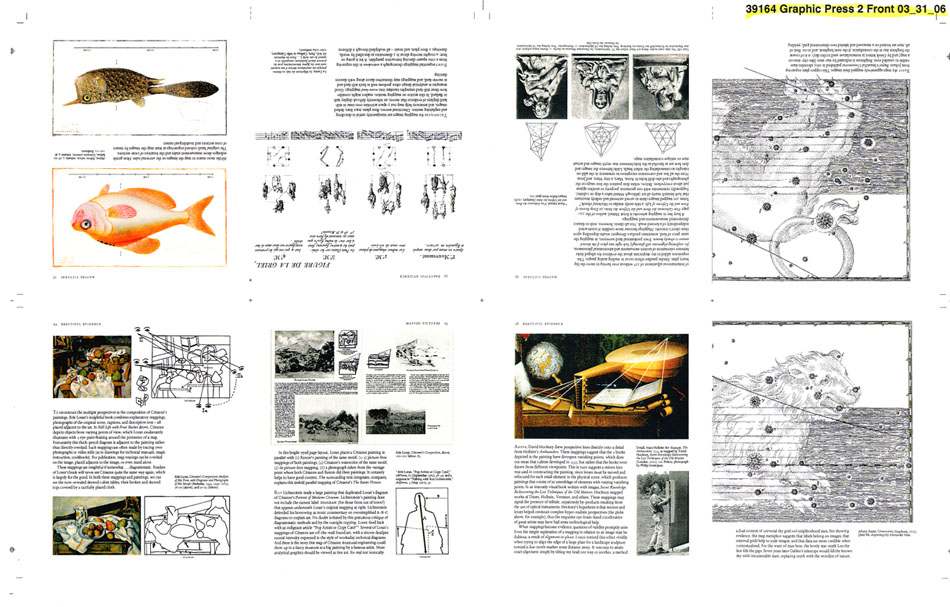 |
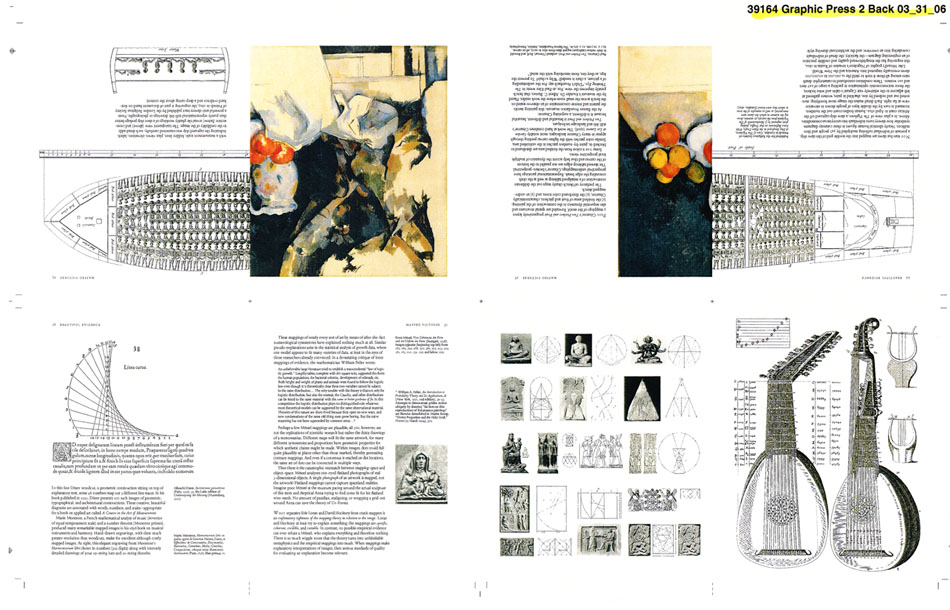 |
-- Edward Tufte
Here are some forms that we are printing tomorrow. Form 6 shows a few pages from parts of a discussion of Hypnerotomachia (look it up) and the beginning of a long discussion of Galileo's Sidereus Nuncius (The Starry Messenger). Form 6 is being "perfected" in the printing jargon, with both sides printed in one pass on a 10-color work-and-turn or perfecting press, so that in one pass of the paper through the 10 presses, 5 colors are printed on one side of the paper, the paper is turned over, and 5 colors are printed on the opposite side. (Thus the one pass prints 16 book pages all told on the 2 sides of the paper). The 5 colors on each side of the paper consist of the standard CMYK along with a separate black for the type. The 2 blacks, as I mentioned earlier, keep adjustments in the density of the type separate from adjustments of black in the images. That way both images and type can be exactly what they should be, with this exception: since the paper passes through the press downwards on the form, local adjustments in the image black (which is controlled across the horizontal) will affect adjacent image on the vertical. Thus, for Form 6-back, black adjustments in the Leonardo image will affect the black in the Bhudda image immediately above. Advanced students of this board may note that Congressman "Duke" Cunningham has made an appearance between Hynerotomachia and Galileo at the very bottom of Form 6-back, second page from the left at the bottom.
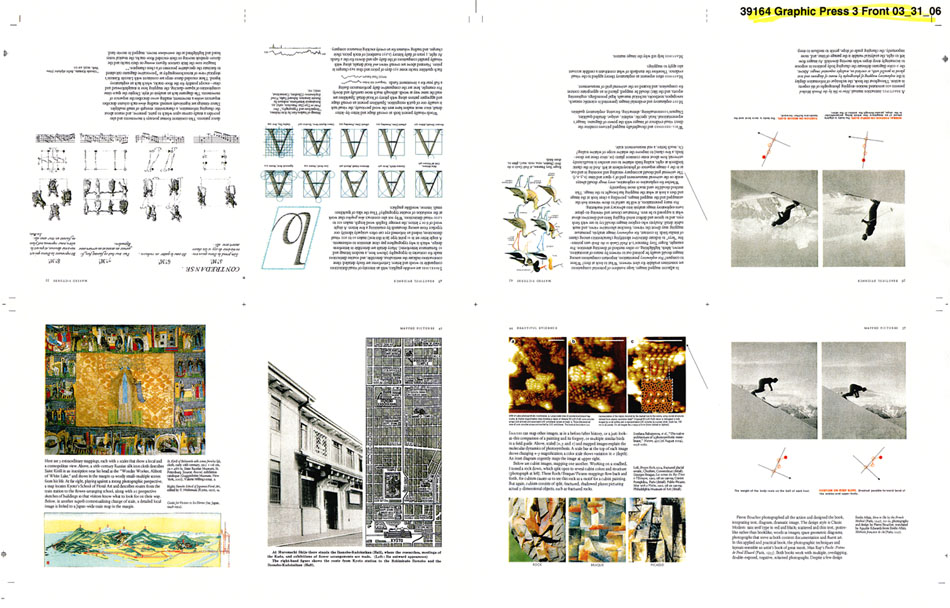 |
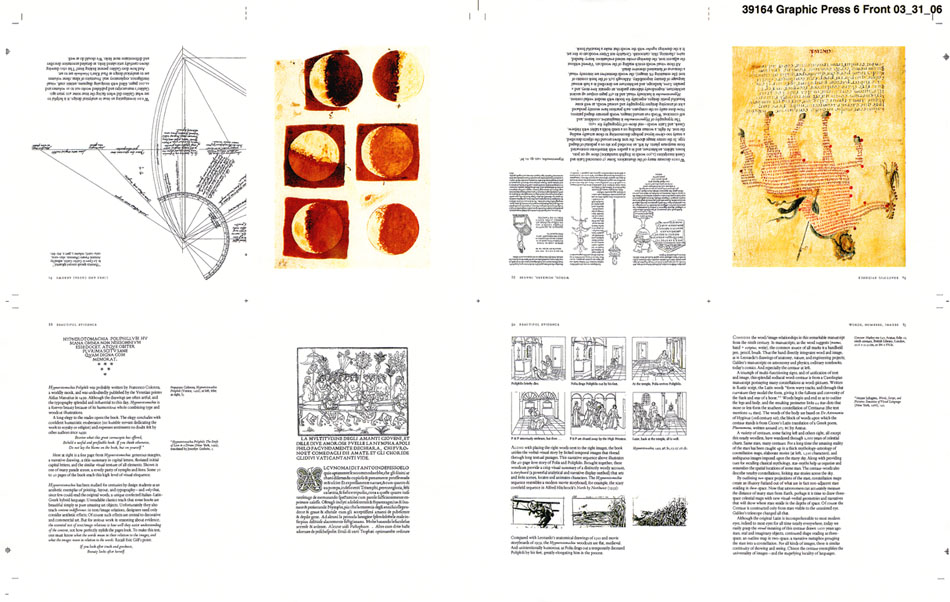 |
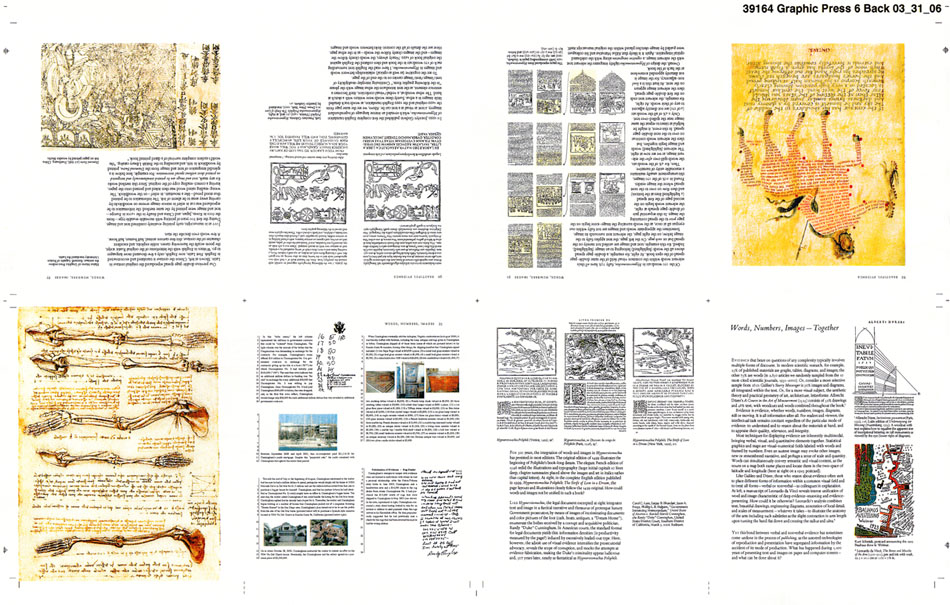 |
-- Edward Tufte
Does how the book is bound place restrictions on the design? I notice on the first form shown that the slave ship and the still life share a common fold within the book. Can you place them anywhere, or are there rules? Did the number of pages you wanted to print determine your binding (or vice versa)?
-- Andrew Nicholls (email)
The plan for signatures (usually 16 book pages) is constructed after the book is written and designed. Our plan was complicated by a fold-out (requiring a 6-page signature, which thankfully fell nicely after a series of 16s and a compensating 8 page form), and by a portfolio of sculpture photos at the end that needed special color treatment. Usually, various workings of standard 16s and a few 8s (where the press sheet is cut in half at the bindery) will yield a book that the be bound efficiently. We've worked for years with Acme Bookbinding (near Boston); they have been superb throughout the binding of 1.2 million books for us since 1983.
As Kindly Contributor Andrew Nicholls mentioned for the Cezanne and slave-ship cross- overs on the same form, there might conceivably some problems with tiny strips of the cross-over pages peeking through into the wrong image. I expect that any problems will be caught up in the binding gutter. Another difficulty with cross-overs is where they fall in folding the forms; the more folds in the sequence of folding, the more the cross-over image can get caught up in the binding. So for a couple of cross-overs (the Columbia slide, for example) I added a little white space in the middle so the text doesn't get caught up in the gutter.
There are also some issues now and then with the way the forms pass through the press (the form flows through the press downward in the forms shown) because the color can't adjusted on one image without affecting adjacent images immediately above or below, as the case may be. That is, we can adjust the colors on the 5 to 9 presses that the sheet passes through on the X dimension across the form, not along the Y dimension. It helps to separate the type black from the image black, which we do, so that the type can be adjusted to the proper density without affecting the image black density in each column of 2 pages. As you can see in the 2 forms shown, the only really competing images (in terms of possible color adjustment conflicts) are the Leonardo arms and the Chinese Bhudda. We've encountered few color adjustment interactions in the book so far.
We're just about done printing. We printed the jacket on Monday (it came out beautifully). We will print the remainder in the next 3 days, finishing up everything this Thursday! Many of the printed forms have already been sent to Acme. It is an enormous amount of paper, which our printer, Finlay, is happy to get off their floor.
-- Edward Tufte
Printing complete on Thursday, May 11. At the bindery, folding is underway. I picked the cloth and the color of the ink stamping on the cloth some time ago.
Major issue now is the carton for mailing single books; the total weight of book and carton is just over 3 pounds, which is a substantial break point on shipping prices. We found a lighter shipping carton that works well to protect the book, but of course it is made in Switzerland.
-- Edward Tufte
Thank you for a very interesting thread. It's a bit like watching the ultrasound of a much anticipated newborn.
-- John McLain (email)
Copies were ready Friday but the bindery was concerned that the glue wasn't dry and thus the shipped copies might warp. So Tuesday it is for the first copies here.
There are certainly some virtues to web publishing, such as glue drying avoidance. But such reflections will vanish when I hold the first book.
And I in fact enjoy the physicality of bookmaking.
-- Edward Tufte
10 copies this morning.
It's wonderful, just about everything I hoped it would be when printed.
-- ET
Congratulations. I can only imagine the feelings associated with opening the first finished book.
Watching the story of the books design and publishing here makes me wonder how the on demand printing and self publishing companies like Lulu and iUniverse will ever be able to compete with traditional bookmaking.
I can't wait to receive my copy.
-- Jake Walker (email)
Lots of books will arrive and then be shipped from our new warehouse this Monday. The staff searched for additional office and warehouse space for about a month and we signed a lease this week. I had hoped that we could put a big sign
W O R L D H E A D Q U A R T E R S
in blocky old-fashioned 3D aluminum sans serif letters on our part of the building but we're alas limited by the lease to a very small signboard.
-- Edward Tufte
Book arrived to reader!
I just got mine in the mail! Thank you for such a wonderful book and a late night tonight reading it!
Best Regards,
Sean
-- Sean Gerety (email)
Details and aesthetics of book production
Aesthetics of book production.
Beautiful Evidence has all the indicators of high-quality, extremely thoughtful, expensive book production:
custom bumper-boxes for mailing (boxes printed on both sides---smart---and the spine), superior text stock and press work, appealing binding cloth, high-fidelity color reproduction, exemplary design combined with graphics and text (note publisher's name: GRAPHICS Press) that actually say something in an accessible, intellectual, and non-belligerent way.
My favorite flourish: actual head- and foot-bands! Huzzah! Someone knows what he's doing, and cares about it.
-- Anonymous (email)
How nice of someone to notice a secret favorite of mine, the scarlet and gold headbands: a little Imhof touch (see EI on Imhof on small bright colour patches), where the colour glows because of its small amount (in a neutral context).
-- ET
A typographic detail in ETBembo is noticed
Speaking of subtle but elegant touches in which contribute to and provide evidence of the attention to the reader, I am grateful for the use of initial/small-caps at the beginning of paragraphs that mark the start of each new thought or example. Bravo! MANY BLESSINGS!
-- Michael W Cristiani (email)
BE tied for rarest book in England
A picture of the rarest book in England (or at least tied for the rarest book in England), taken in London at the Stafford Hotel during my visit this weekend. BE is on the table.
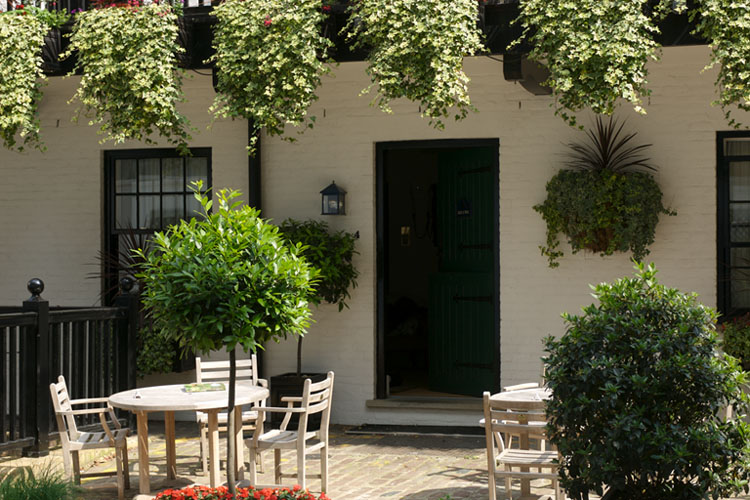 |
-- Edward Tufte
Reader receives Albers and ET on same day
It feels like winning the post office lottery. My copy of Beautiful Evidence arrived yesterday at the same time as Albers's Formulation: Articulation, newly published in book form by Thames & Hudson (printed in Germany by Steidl Verlag). Both are stunning examples of the craft of fine bookmaking. A fine marriage of elegant design and intellectual rigor. Thanks for not compromising.
-- Brian Burch (email)
Likes Goldens on cover
Please indulge a personal appreciation for the cover photos. My copy of the book arrived at a bittersweet time: we were losing our beloved golden retriever to cancer, and awaiting the arrival of a GR puppy. The photos are indeed beautiful evidence of the spirit of these magnificent dogs.
-- Gary Radice (email)
Distinguished scientist likes BE
Like all the others who have commented, I was delighted with my copy of Beautiful Evidence when I received it about three weeks ago. However, I didn't immediately say so here because I wanted to write some unbiassed comments for Amazon first. It made no difference because, unbiassed or not, one can hardly avoid superlatives when writing about it.
Like, I imagine, most readers who read them with an open mind, I am thoroughly convinced by the arguments for embedding images in the text at exactly the places where they are relevant, but I am curious about the software used to achieve this in the book. For articles published in periodicals one is normally forced to follow the editorial practices of the periodical, no matter how stupid they may be, but for books one may have a little more control, even without going to the extreme of setting up one's own publishing house. (I'd love to be able to emulate Graphics Press and have complete control over everything, but that must involve a large investment of time, effort and money.) The references to Microsoft Word in Beautiful Evidence suggest that this was used at some stage, but surely not for the complete layout of the book? I'd be prepared to invest in a complete layout program if I could be sure if would let me do things the way I want and not insist on imposing the software designer's choices.
In this connection it is pertinent to mention LATEX, which I have recently started to use for preparing scientific articles, because it illustrates very well both the advantages and disadvantages of a page layout program. On the one hand the typographical choices that it makes are expert ones, and a huge improvement on many people's amateurish ideas of typography, but on the other hand it makes it difficult or impossible to do anything differently from what Donald Knuth decided.
-- Athel Cornish-Bowden (email)
What's with the cartoony elephant and the centaur?
The change from the scatterplot on page 118 to the one at the bottom of page 121 is striking. However, a question about the representations of the animals -- why the cartoon-y elephant? and while I was looking at that, I realized a centaur has also galloped its way into the plot. We can possible estimate the body mass of a centaur (0.75 horse + 0.5 human), but the brain mass is entirely human. I do not know the body mass of a horse, but since this is on a log scale, it seems to be too heavy!
Shrirang
-- Shrirang K. Karandikar (email)
Both the elephant and the centaur are back-references for insiders.
The "cartoony elephant" is of course Babar (Google it), who also appears in my Visual Expalantions, pp.127-129 and in our Babar Thread.
The centaur appears in Beautiful Evidence, in Latin and in English, at pp. 84-87, opening the chapter that concludes with the log-log plot of the animals.
That scatterplot makes several other jokey references: Matisse's goldfish painting, the Pioneer spacecraft plaque human beings (see my further joke on that here), the skeleton pre-historic animals (since they have never been directly photographed alive), and some others.
Several readers have written about the differences between the original log-log scatterplot and our redesigns. The Sagan-Jerison original got several data points wrong, which are corrected in my versions of the original. This is in fact noted, perhaps too elliptically, in my text on page 111: "Such plotting errors . . ."
Since nothing kills humor more than having to explain it, and since humor does not travel well, some writers (John Kenneth Galbraith, for example) recommend that humor should be avoided entirely. In practice Galbraith does not follow his own advice, for which we should be grateful, since much of his work is very witty and indeed at times richly humorous. Now and then failed humor proves informative about the attitudes of the reader: at this board, the note at the top of our complete list of topics, " *** = 3-star threads", a parody of insecure and over-explanatory interfaces, has for years induced the earnest and the malicious into denouncing the definition of 3 stars.
From an author's point of view, the best thing about humor is that some readers do get it.
-- Edward Tufte
BE briefly #10 on amazon books
After appearances at kottke.com, on NPR, at an IHT slide show, and with 2 threads on this board slash-dotted, and, to top it off, with amazon selling the book at below cost to them, Beautiful Evidence swiftly went to #10 on the amazon best-seller list (one informant reported #6).
But then, as a horrified nation rose up as one in disbelief, Fat Smash (diet book) and Gut Solutions (treatise on improving intestinal tract operations) surged past Beautiful Evidence when, 2 or 3 days later, amazon raised BE's price back to full retail.
I am happy to report that Beautiful Evidence is doing really well despite our non-existent marketing strategy and dynamically inattentive marketing. Our only ad was a cryptic page, just the BE front cover of Max diving, in Harper's last April. Now we don't dare advertise because the staff is already too busy shipping out books. The staff found a big new warehouse for Graphics Press, reorganized operations, and then patiently explained to me what they had done. I am endlessly grateful to the staff and Beautiful Evidence opens with their names on the dedication page.
There are reportedly stories relevant to the book or reviews coming out in the New York Times, Bloomberg, ID, and a profile in the Stanford Alumni Magazine, but such things are always uncertain until they actually appear in print.
-- Edward Tufte
One of the best things about a new book is renewing links with old friends and hearing what they have to say. Here's a most generous response to Beautiful Evidence, from a former editor at the Times book review:
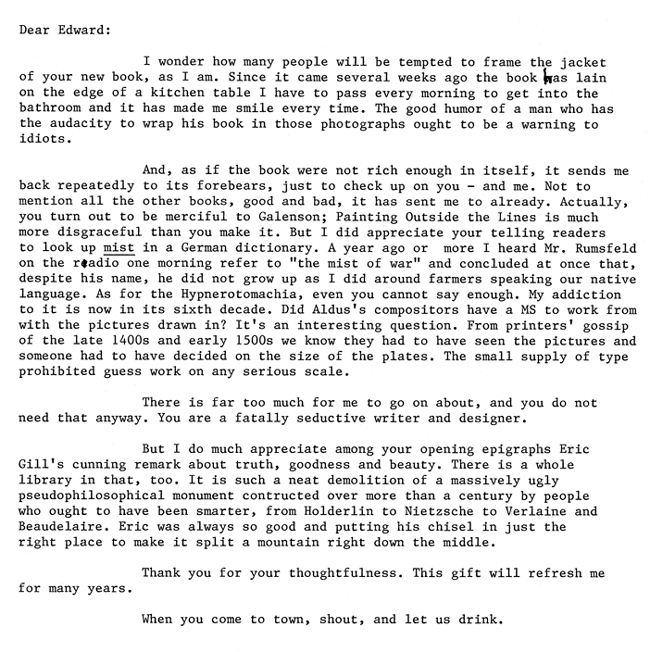 |
(Eric Gill's "cunning remark" in the BE epigraph is "If you look after truth and goodness, beauty looks after herself.")
-- Edward Tufte
With regard to the question about sales and marketing, short-run surges are obviously explained by particular events. The amazon surge was a lucky confluence of multiple events, which in turn had a halo effect on the other books.
The internet has helped BE a great deal and has seemingly reduced the need for conventional print advertising, at least in this idiosyncratic case. Maybe later some kind of print advertising would be helpful.
About one-third of BE was posted in early draft form for comments at this board. This got some important ideas out (for example, sparklines, the Columbia analysis), which was my goal, several years before the book itself was published. Thoughtful eyes looking at the new work in draft helped improve the book. It is impossible, after the fact, to measure the sales consequences of the early draft releases (although they have surely helped in the short-run). But the point was to put some ideas out and receive helpful comments, whatever the marketing risks or consequences.
During the first few years after starting self-publishing in 1983, I tried to figure out the causes of sales by looking at the data, but then we got too busy shipping books. For whatever reasons, the business strategizing stuff of financing and marketing has seemed common-sensical and best handled by trying to minimize my attention to the business side. The amazing staff does very well with the business, which gives time for my book work.
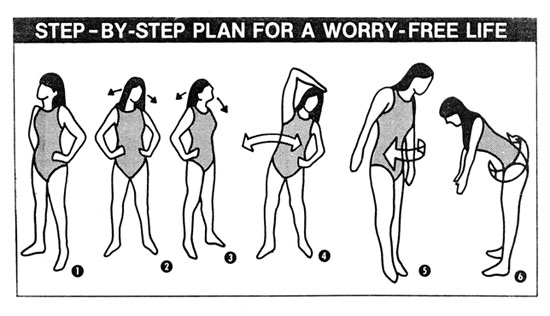 |
-- Edward Tufte
Beautiful Evidence opens with 3 epigraphs opposite the title page:
"What was
observed by us
is the nature or matter of the milky way itself,
which, with the aid
of
the spyglass,
may be observed so well that all the disputes
that for so many
generations have vexed philosophers
are destroyed by visuble certainty,
and we
are
liberated from wordy arguments."
Galileo Galilei
"Medical statistics will be our standard of measurement:
we will weigh life for life and
see where the dead lie thicker,
among the workers or among the
privileged."
Rudolf
Virchow
"If you look atfer truth and goodness
beauty looks after herself."
Eric Gill
Frederick Crews' new book, Follies of the Wise: Dissenting Essays, ends with a thought that belongs with the Beautiful Evidence trio:
"The human race has produced only one successfully validated epistemology, characterizing all scrupulous inquiry into the real world, from quarks to poems. It is, simply, empiricism, or the submitting of propositions to the arbitration of evidence that is acknowledged to be such by all of the contending parties. Ideas that claim immunity from such review, whether because of mystical faith or privileged 'clinical insight' or the say-so of eminent authorities, are not to be countenanced until they can pass the same skeptical ordeal to which all other contenders are subjected."
Beautiful Evidence, at its heart, is about how empirical information (particularly visual information) turns into meaningful and credible empirical evidence, what Galileo called "visible certainty." The argument is made explicitly in the chapter on evidence corruption, and, throughout the book, by all the practical examples undergoing the "skeptical ordeal" described by Crews. Also this point is the main subject of the introduction. That's why the book is called Beautiful Evidence.
-- Edward Tufte
For early December, we're preparing for the second printing of Beautiful Evidence: typos corrected (thank you everyone), some microscopic typographical repairs (certain kerning pairs associated with the apostrophe were loose, a few periods floated away from the last letter in the sentence, and similar).
Substantial changes will occur in the landscape sculpture section (privately called "My Back Pages," for several reasons). I've decided with each Beautiful Evidence printing to bring in some new sculptures and some new pictures of previously published sculptures in a changing portfolio of the work. "My Back Pages" and preceding chapter on sculptural pedestals both signal, cryptically, a move from the flatlands of representation to the spacelands of reality--the direction of some of my work in the next few years. The revisions of MBP with each BE printing enable experiments with new material in print, just as this website does more informally and without the discipline of print design and publishing. It also allows some tests for a major show catalog I hope to work on the next year or so.
-- Edward Tufte
The changes in the second printing will be (1) repaired typos, and (2) new and revised pictures on about 7 of the 14 landscape sculpture pages at the end. I have better pictures of some pre-2006 pieces and also pictures of new 2006 pieces to show. The copyright page will say that this is the "Second printing, December 2006."
Otherwise, changes in new printings, I believe, should be made silently. When there's a new edition, however, an explanatory paragraph in the preface is helpful, partly to justify why the book is called a new edition.
Mostly minor and a few major changes have been made all through the 42 printings of the 4 books; my staff and I usually get most minor errors cleaned up by the second or third printing. Color adjustments have persisted through many printings as we gain experience with various printers doing the books and with the images themselves.
-- Edward Tufte
For several images that were somewhat heavy in the first printing, we've done substantial undercolor removal (reducing the amount of ink by 4% to 7% across CMYK). I wanted a lighter cleaner look. Also the first printing tended to yield too much magenta in some key images and so we've reworked the color balance considerably in about 5 images.
In color adjusting my photographs of the landscape sculptures, I find the camera language of Aperture more congenial than Photoshop language. Except Aperture crashes a lot, at least with the big files of RAW images, 4GB memory card downloads, and an impatient user. Everybody else happily uses Photoshop.
We'll be doing some test printings of the new color images at the printer as soon as we complete some color revisions, and then do more revisions after seeing those tests.
-- Edward Tufte
On Sunday November 26, we placed an ad for Beautiful Evidence on the website frontpage of The New York Times.
This was the first BE ad; it did well and attracted many visitors to our forum and shopping cart.
NYT web ads run midnight to midnight; here's a screenshot shortly after the ad went up.
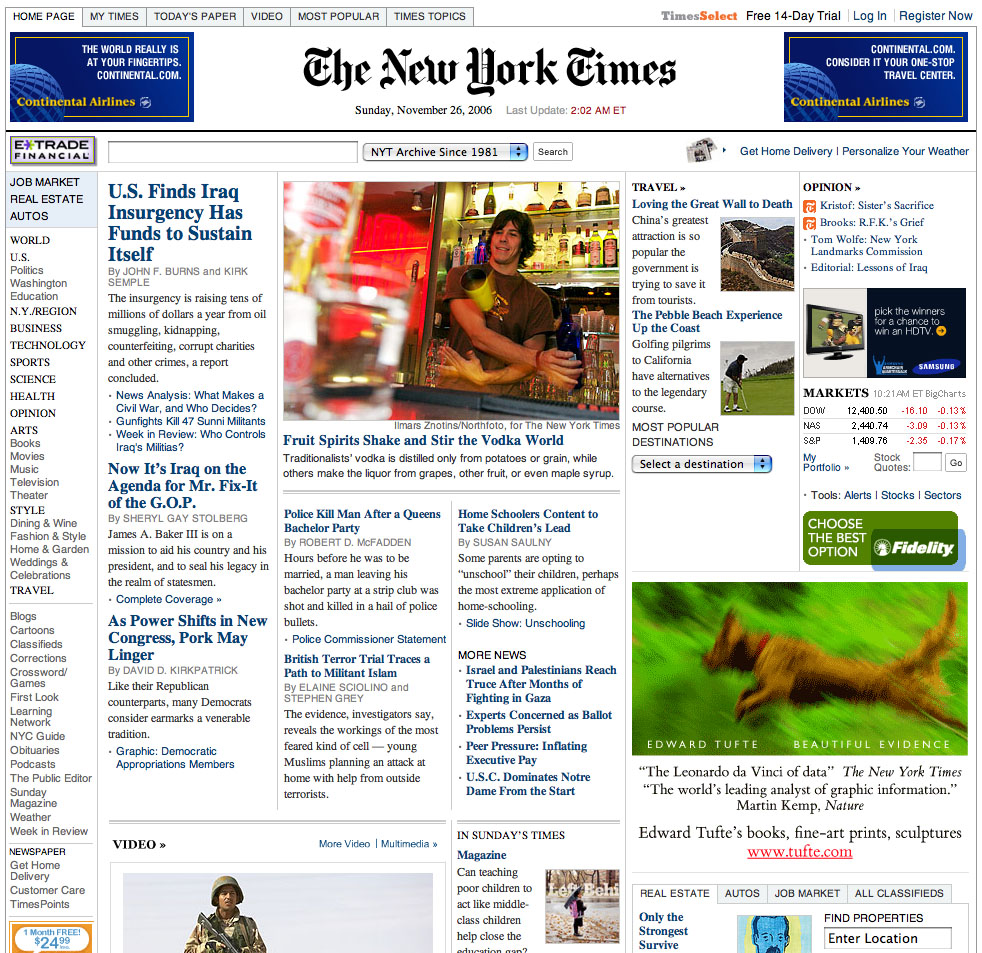 |
After yesterday's announcement of the Apple iPhone,
a colleague sent me an email saying that the image "Max Diving"
had appeared on the sample iPhone screen.
To show the internet on the iPhone, Apple chose . . . . the NYT frontpage of November 26!
We're thrilled.
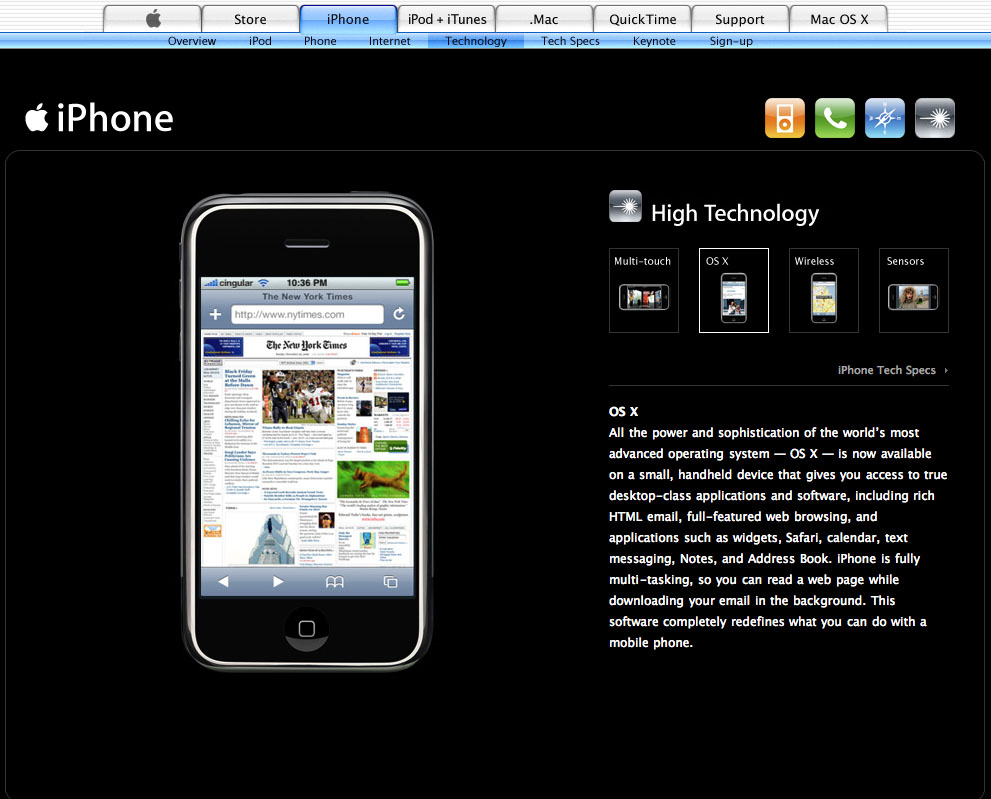 |
-- Edward Tufte
First awards for BE
Recent notable appearances of Beautiful Evidence:
Bloomberg, Best Innovation and Design Books for 2006 here and here
ZDNet, Best Business and Technology Books of 2006 here
Christianity Today, Book of the Week here
"So they finally gave it to me," I thought, scanning the latest CT.
I mentioned CT's scholarly and
thoughtful review ("reading ET is a life-changing experience") to a colleague,
who, illustrating the excesses of our cynical times, said
"That's The Onion!"
"No it's not! It's really Christianity Today".
"You just made this up, like that news story about the Sumatrian Boring Water Snake."
"Nope."
-- Edward Tufte
A problem with paper
A serious problem--specks on the paper--arose last week when we began the second printing of Beautiful Evidence. At the press OK, the printer and Carolyn Williams (Graphics Press Executive Editor) were chasing specks and spots (mostly tiny but visible gray slightly lumpy specks) on the paper stock. In the old days of film negatives, specks usually resulted from tiny holes in the negatives. Now printers use direct-to-plate digital methods that eliminate film and thus most specks, and it turned out the specks were in the unprinted paper stock itself! The result was a title page with several gray specks sometimes wandering around the title Beautiful Evidence and the other pages as well.
I then looked over the following: sheets from 2 newly printed forms; the blank new paper; the printed forms from the first printing 7 months ago; some blank sheets left over from first printing. No specks appeared on any of the paper for the first printing. After a night of meditation and looking at the freshly printed sheets several times, I decided that the specks were unacceptable and that we could not print the book on the stock provided by the paper mill.
This decision creates two serious problems. First, what to do with 1.1 million sheets (5 tractor-trailer loads) of paper with specks and spots? Second, and more importantly, we're running out of books from the first printing; we need to get the second printing done, bound, packed in cartons, piled on pallets, and, indeed, shipped real soon.
The paper company promptly rejected our complaint about the specks; they said the paper was made 30% post-consumer waste and that's what you get when PCW goes into the mix. The paper company also argued, in effect, that the specks were not bugs but features--because the specks indicated that the publisher was virtuously using paper that contained recycled material. The paper mill also said that some corporations in their annual reports used paper with a lot of post-consumer waste to demonstrate their environmental credentials. The analogy of our bookwork to corporate annual reports was unappealing to me.
I guess the paper mill expected us to eat the specked-up paper or go ahead and print the book on the flawed paper. Our argument was that we had ordered, for the second printing, exactly the same paper used in the first printing (which, of course, had no visible specks). They suggested that we got lucky in the first printing. We countered that our printer, who has often printed on this paper, had never had specks like this before. The matter was further complicated because the paper merchant had already paid the mill but we had not yet paid the paper merchant since the paper was not completely delivered to the printer.
At a meeting of the paper-mill people, the paper-merchant people, and my Executive Editor and myself the other day, we were pitched about the virtues of specks and shown printed work that had specks. I said in 24 years and 47 printings of the books we had not deliberately published any specks. What to do?
In mess-ups like this, my philosophy is that lawyers are to be avoided as long as possible, that no one in the business relationship should profit from a screw-up, that some problems have no blame to be assigned, and that, most of all, we get on with our bookwork.
I proposed that we would use the flawed paper for our ephemera printing (junk mail, catalogs), but that we would buy the specked paper only at the cost of our ephemera paper--thus we would pay about 30% less than invoiced for specked paper. But the main problem was that we needed books--and therefore good paper--real soon. Thus I proposed the paper mill should make another batch of paper ("virgin paper," as it is called, without post-consumer waste) right away for our purchase; interestingly enough, the hundredweight cost of virgin paper is the same cost as paper with 30% PCW. In my proposed arrangement, the paper mill comes away right now with another very big order to replace the specked paper. We wind up with more specked paper than we would ever want but we can use it up over a couple of years of ephemera printing. The paper-mill people seemed agreeable; the paper merchant was, of course, delighted. There are, however, some final negotiations, the results of which I should hear about soon. There are also massive but solvable warehousing problems as well; we're working that out with another printer.
For the first two books, in 1983 and 1990, I paid close attention to business stuff because we needed a lot of capital ( = second mortgages on our house) to do the work at the level I wanted. But since 1991 two staff members have handled the business very well; on big matters, the staff runs the issues by me and I usually grunt "yes, fine" and go back to my studio.
So what did I learn from this?
First, about paper merchants. After the meeting, the paper merchant, who was very helpful in all this, took us on a tour thorough his vast warehouse of skids and skids of paper. I asked "Why paper merchants? Why don't mills deal directly with, say, Graphics Press?" He explained that they served as local distributors for many small lots of paper from many different mills. And the merchants also serve, in effect, as banks to finance undercapitalized printers (who pay the merchant very slowly) and paper mills (who are paid by the merchant quickly)--the float. If the paper buyer pays the merchant quickly, as we do, there are substantial discounts--appropriately since the merchant isn't financing us.
Second, the symbolic role of post-consumer waste. By means of specks in paper publications, corporations can conspicuously demonstrate their environmental credentials. And graphic designers who specify a PCW paper for a lucrative annual report can go the bank with a therapeutically untroubled conscience even though the annual report was for a tobacco company--for, after all, the designers used PCW. My symbolic use of PCW was to bring a roll of toilet paper, gift-wrapped, to the meeting, but I then tactfully decided to forego my demonstration that many of the specks were identical in color to the gray cardboard cylinder holding the toilet paper.
Third, it is always interesting to poke around in another world and see what is going on. I had toured the paper mill and also the paper merchant years ago to see the physical side; here I saw how the business side works.
Fourth, I was thankful that we concentrate entirely on bookwork and do not have to play around with slow paying or with trying to exploit financially this mix-up. I am grateful that we could slip out of this situation without specks on 70,000 new books.
-- Edward Tufte
The new unspecked (we do hope) paper for Beautiful Evidence has been made and sheeted; it will arrive in a few days at the printer. After the paper is conditioned (by sitting at the printer for a few days), then we can start again.
-- Edward Tufte
Max on cover leads to BE in Pets section of bookstore
This email arrived last week:
"You might be interested to know that the dogs swimming cover on your new book, Beautiful Evidence, led to the book being sold in the pet section of our local Barnes and Noble. I found the book because I was looking for a book on cats."
For some reason, this makes me very happy.
-- Edward Tufte
Printing images of Leonardo's drawings
Below left, Leonardo da Vinci's The Bones and Muscles of the Arm (1510-1511) from the first printing of Beautiful Evidence. And on the right, from our new second printing of Beautiful Evidence.
We had a difficult time with this image in the first printing; too brown, too murky, and, then at the press OK, the image turned up with a moire! So some live Photoshop work was done, the plates remade, and the image came out blurry when they started printing again a couple of hours later. This happened early in the first BE printing and very upsetting (I almost pulled the job).
A few months later, I saw the same image in Martin Kemp's catalog for the Leonardo exhibition in London. And the image looked great--lighter, non-brown, and clean. So we decided to start over for the BE second printing. We emailed the Queen (who owns the original Leonardo) and asked for different photograph of the image. It turned out that there were a variety of photographs of the Leonardo drawing taken over the years.
Then we (not the printer) then did some minor Photoshop work (undercolor removal in the CMYK file, despecking). The result, seen here at right, is an image quite close to what Kemp showed in his Leonardo catalog.
By the way, the left image is less bad on the computer screen (as a result of backlighting) than on paper (in reflected light off the paper the image is heavier and browner). Our new BE2 image on the right looks a little light on the computer screen but just fine on paper.
 |
-- Edward Tufte
Second printing and binding complete
The students in the one-day course received the first copies of the second printing of Beautiful Evidence this week.
I'm very happy with the revisions: cleaning up several images, correcting a few typos and infelicitous phrases, many images of new work in the sculpture section, and an introduction to the sculpture section explaining the point of moving into spaceland and real-land.
There are now 124,000 copies of BE in print.
-- Edward Tufte
Page number puns?
The care with which Tufte's books are composed is exemplified by the placement of J. Bayer's Uranometria engraving precisely on page 20 of Beautiful Evidence.
Notice that the top number on the "y" axis on the left edge of Uranometria is "20," and that this "20" in the engraving lands exactly where a reader would expect to find printed page number 20 in Tufte's book (after turning the leaf from page 18). In this way a detail in the engraving both refers to itself and points outside of its border in an unexpected and pleasing way.
Perhaps we could say that readers noticing this detail possess 20/20 vision.
-- John Bendorf (email)
Fortuitous?
What a thoughtfully sympathetic reading of a pure luck-out (as I can best recall). If I had spotted it, I would have done it. Maybe the staff will remember something about this.
My page layouts tend to drop a bit too many page numbers as I try to avoid page-number specks that might disturb the image.
I'm delighted that John Bendorf spotted this fortuitous subtlety.
-- Edward Tufte
BE award
My jacket for Beautiful Evidence came in first in the Print annual New England design awards:
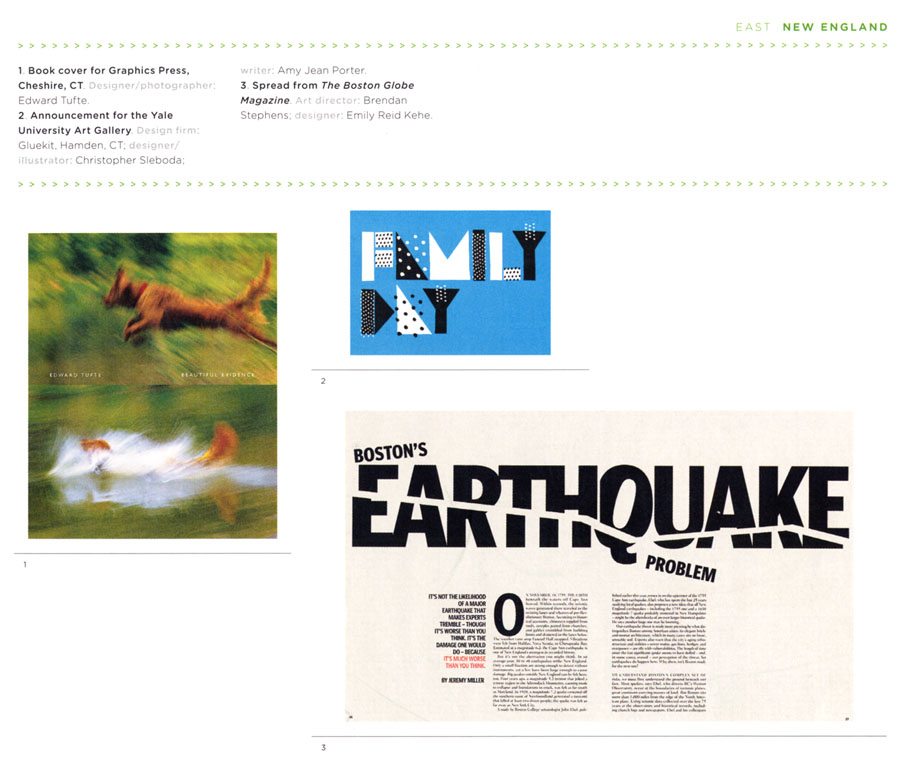 |
MIT and Yale University books/ephemera won 7 of the 45 runner-up awards.
-- Edward Tufte
Another award
See "Madam Mayo's Top 10 Books Read in 2007" and a nice comment about the one-day course.
-- Edward Tufte
Brilliant catch of error identifying typeface
A small error in identifying a typeface appears on p. 65 of Beautiful Evidence. The typeface used in Alfred Barr's diagram "Cubism and abstract art" (p. 64) is not Futura as identified in the text, but Vogue. This face is seldom seen today, but was fairly common for sans-serif captions in newspapers and books until the 1960s. Many of the letterforms look similar to those of Futura, so the error is quite understandable. Futura obviously influenced Intertype, the corporate designer of Vogue; it dates from 1930, just a few years after Paul Renner designed Futura. However, compare the numerals used for the years in the diagram to those of Futura, and you can see the difference. In fairness to Edward Tufte and his excellent book, typography has been one of my special interests for years. Few others would have noticed the difference either.
-- Ed Krampitz Jr. (email)
Vogue v. Futura typefaces
This is an excellent find by Ed Krampitz Jr.
Comparisons of Futura and Vogue indicate subtle differences in at least 8 capital letters.
I'll correct the text in the third printing of Beautiful Evidence.
-- Edward Tufte
Galileo's Sidereus Nuncius
Page 108 of BE presents the chronology of the dance of Jupiter and his moons between 7 January 1610 and 2 March 1610. This stack of observations shows the advantage of the small multiples principle. On page 109, the annotations pull the whole story together.
I have a question/request: Since these images are placed vertically relative to time between observations, is it not true that each individual moon show trace out some sort of smooth sinusoid as we move down the page in time? There is reference to the corkscrew structure of the data at the top of the page; is it possible to redraw the plot with the planets superimposed over the four sinusoids that are present in the data?
Are the individual orbits of the moon too rapid to make such a tracing helpful? I read (Wikipedia) that Io's orbital period is approximately 1.77 days, Eurpoa's 3.55 d, Ganymede's 7.15 d, and Callisto's 16.7 d. Could your designers redraw the plot as the original but with four copies, one with each of the moon's orbital paths gently laid out in the background across time, maybe the path under investigation in a grey with the other paths floating even farther in the background in lighter grey? Or perhaps all together on the same stack?
Callisto should make only about three full cycles across the entire time frame while Io would make more than than four per week.
If the math were done right, it should be possible to identify each moon across the sequence, at least to the precision of which one falls closest to each path.
Could we see such a figure? Would it help if I said "Please"?
Thanks, Rafe
-- rafe donahue (email)
Corkscrew diagrams for Jupiter
What you want to see, almost, is on pages 96-101 of my Envisioning Information.
The Galileo material in Beautiful Evidence is a substantially shortened version of the original manuscript, with 3 or 4 pages cut before BE was published. That section was turning into Galileo scholarship (where my work is very modest compared to that of real Galileo scholars), and turning away from visual thinking. In the redacted pages, I matched up plots of the now exactly known (retrospectively extrapolated) corkscrew pattern during the days of Galileo's observations, did an error analysis, and critqued a previous error analysis (note the drift into Galielo scholarhip). Cutting out those pages allowed me finally to organize and finish a complex chapter, where Galileo's work was a long bridge between Hypnerotomachia Poliphili and Newton's Opticks, with a brief pause for the corrupt member of Congress "Duke" Cunningham. Someday, that material might well be put up on the board, perhaps on the 400th aniversary of Galileo's observations of the Galilean satellites of Jupiter. (I was recently invited to give a talk in Rome at a conference, otherwise populated by real Galileo scholars, celebrating Galileo's work on Jupiter.)
Rafe noticed my favorite part of the analysis, the visual-verbal diary of discovery on page 109, where I dared to redesign Galileo's Starry Messenger. No one else has ever noticed.
-- Edward Tufte
Did Max appear in Pixar's UP?
I noticed during the closing credits of Disney/Pixar's film "UP", that I may have spotted a Beautiful Evidence cameo.
In the rolling credits, they used snapshots of Carl Fredricksen, Russell, Dug (the golden retriever) to show they were all part of each others lives post the story of the movie.
In one of the snapshots, it had 3 or 4 pics of Dug jumping into water...I just caught it out of the corner of my eye as I was packing up my kids to leave, but I thought that they may have used Beautiful Evidence for inspiration of that snapshot.
-- Jake Jacobson (email)
Third printing
My staff is planning the third printing, another 70,000 copies, of Beautiful Evidence. If anyone has changes, from typos to conceptual errors, please let me know at this thread.
Thank you,
ET
-- Edward Tufte
Beautiful Evidence meets Richard Serra
In Chelsea today, Richard Serra watched over the delivery of artworks
for his show Junction/Cycle at
Gagosian, opening September
14.
I introduced him to Beautiful Evidence.

-- Edward Tufte
Richard Serra in Beautiful Evidence
The concluding chapter of my Beautiful Evidence moves from the flatland
of the computer screen and paper into 3-space. I suggest that Sculpture's
pedestals are the equivalent of Data Graphic's chartjunk and PowerPoint's
phluff. The opening spread below concludes with Richard Serra's demolition
of the pedestal.
Source: Beautiful Evidence, pages 186-187.
| |
|
-- Edward Tufte
2013, fourth printing of Beautiful Evidence
A big new run of my now-favorite book of the four,
I think because Beautiful Evidence is mostly about high science and high art.
-- Edward Tufte
|
||||||||||||||||||||


